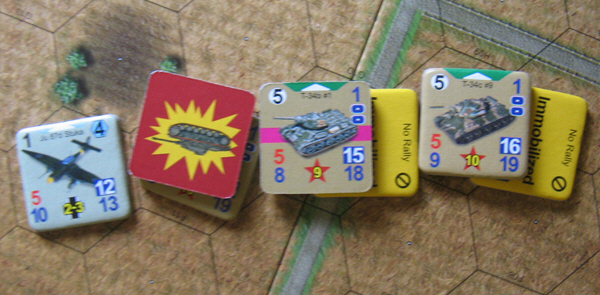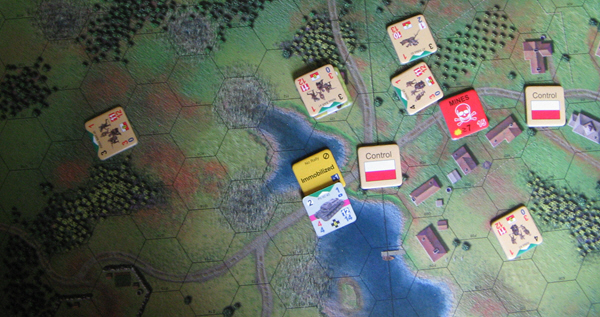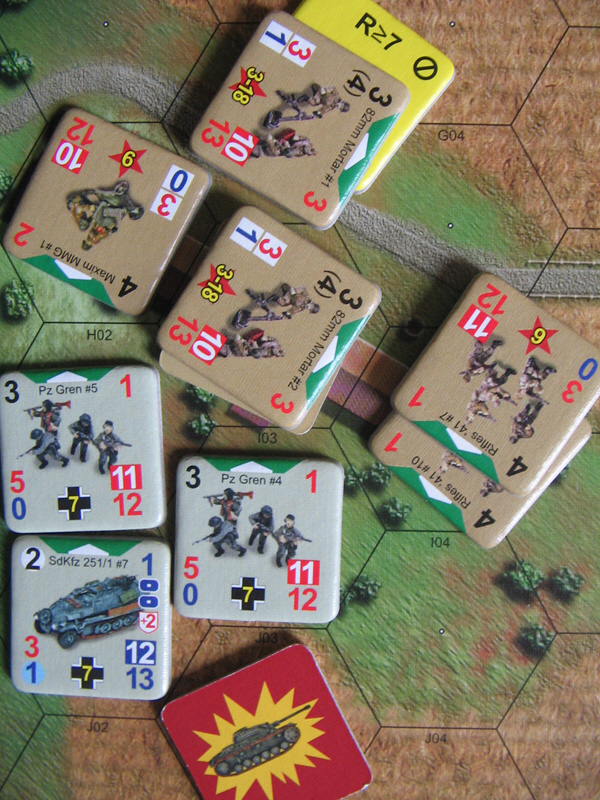Conflict of Heroes – Boardgame Review
 Conflict of Heroes – Storms of Steel & Price of Honour. Boardgame Review. Publisher: Academy Games. Designer: Uwe Eickert. Storms of Steel $80; Price of Honor $50.
Conflict of Heroes – Storms of Steel & Price of Honour. Boardgame Review. Publisher: Academy Games. Designer: Uwe Eickert. Storms of Steel $80; Price of Honor $50.
Passed Inspection: Well-written and illustrated instructions, simple but dynamic playing system, beautiful quality products, solitaire rules included, complete web and telephone support.
Failed Basic: More airplanes needed. Vehicle facing on the counters is counter-intuitive (no pun intended). Needs markers to show what units are active for the turn. Map hex coordinates are a little difficult to read.
As the 30 Panzer Grenadiers and their support elements moved down the sides of the road towards State Farm 158, mortar shells began to pelt the area and a well hidden Maxim MG team opened fire on their forces. The crew of the Germans’ 8cm mortar located the Russian mortar team and returned fire. The Grenadiers assaulted the Russian MG team, which was supported by a force of riflemen and a team armed with submachine guns. The fighting bogged down as the German mortar team was vanquished by some well-placed Russian artillery. Just as things looked bad for the Grenadiers, a Panzer III and a Panzer IV showed up as fire support and the Russian platoon in the wheat field was effectively destroyed.

But in this teeter-totter fight for Farm 158, things were not stabilized. Three T-34s arrived and the Pz IV opened fire. Its 75mm high velocity cannon immobilized one of the T-34s but it couldn’t penetrate their frontal armor. Soon the Pz IV was a smoking wreck as the Pz III maneuvered for a flank shot only to be hit by two well-placed Russian shells which removed the Pz III from the equation. The Panzer Grenadiers prepared to face the two oncoming T-34s when help from above arrived. A Stuka G armed with 37mm cannons swept down and destroyed the immobilized T-34 before easily knocking out the other two Russian tanks. A back up team of Grenadiers arrived in a Sdkfz 251/1 and stormed the mortar positions which, it turned out, were also supported by another Maxim MG team.
The Conflict of Heroes games are easily the best board games I’ve ever reviewed for Armchair General.
Another Russian tank was sighted moving across the wheat fields; it was a T-70, thank God, and not another one of those damned T-34s. The Stuka made another run and with the last of its ammo smoked the smaller Russian tank. Suddenly the sound of another airplane was heard and the circling Stuka exploded! A Russian Shturmovik, aka “The Flying Tank”, had blasted the Stuka in to bits but then, spotting something in the distance, flew Southwest. The few remaining Russian troops gave up or escaped and, as one team of Grenadiers secured the remaining area, the other German troops began evaluating their heavy casualties. State Farm 158 was secured but at one hell of a cost. This battle would not be easy no matter what high command promised.
{default}So ran Solitaire Scenario 4 which was included in Academy Games’ Storms of Steel! – Kursk 1943 game which is part of their Conflict of Heroes game series. Rules are included for playing this scenario with up to 4 people as well but as originally set up as a solitaire game it ran just fine.
Academy Games was envisioned as an educational gaming company by president and designer Uwe Eickert when he started the company in 2008. After studying the marketplace, Eickert decided to create Academy by releasing extremely high-quality war games. Originally envisioned as rules for World War II miniatures, 2009’s Conflict of Heroes: Awakening the Bear was released with maps and counters instead of miniatures and won both the 2009 Origins Award and the 2009 Charles S. Roberts award for best historical game. Storms of Steel (Conflict of Heroes’ Kursk expansion) and Price of Honour (Conflict’s invasion of Poland expansion) are the second and third in this on-going Conflict of Heroes series and continue the award-winning tradition of the out-of-print Awakening the Bear.

Both Storms of Steel and Price of Honour feature newly designed and updated rules, scenarios and counters which are more pleasingly designed and user friendly than those that appeared in the original Awakening the Bear. The maps are also much more realistic looking – the graphics are almost “photo realistic”.
The heart of the Conflict of Heroes system are the simple but very complete, well-written, and nicely illustrated rules. Each rule section walks the new player through more and more details and references the player to specific scenarios in order to familiarize himself with the system. As the player gets deeper in to the system itself, rules which add airplanes, armor, fortifications, etc. lead the player to experiment with more complex scenarios until the player is almost effortlessly immersed in the complete rule set. Eickert is also to be commended for including a complete index for fast reference as well as cheat sheets, which come in very handy during play.
Each round is made up of phases where a unit is activated and can then spend up to seven action points (or more depending on the scenarios and rules used) as well as CAPs (Command Action Points) in order to move, attack, sneak, turn a turret, dive to strafe, etc. After the unit makes an action, the other player can activate units in order to react to the dynamic battlefield situation. This move-react system keeps all players’ attention on the game and makes for some very tense moments.
Each unit in Conflict of Heroes is a squad, special weapons team (mortars, machine guns, flame throwers, etc.), vehicle (half track, tank, wagon, etc.), or an airplane.
The play is influenced by random Action Cards, Weapon Cards, or Veteran Cards. Action Cards are kept hidden by the owning player and used to influence the game. Some examples are Rally Attempts, Bogged Down, Sniper, etc. Weapons Cards are, as would be expected, weapons that are either on-board, such as Magnetic Mines or Molotov Cocktails that can be added to a squad’s arsenal, or off-board artillery such as Nebelwerfer 30 cm Rockets or Russian 122mm Field Howitzers. Veteran Cards are assigned to a squad and include such things as 6th Sense, Good Leadership, or High Morale.

Each of the beautiful, very sturdy and large full-color counters include ratings for Cost to Fire, Firepower HE or AP, Range, Cost to Move and Front and Rear Defense. Each counter also has information relating to the forward arc, open-topped/backed vehicles, gun screens, etc.
As the units engage in combat and special cards are played, the player can also use Command Action Points to influence the fight. Each of these CAPs represents communications, the unit’s ability to think creatively, and the command/control of the army (German, Polish, Russian, etc.).
When the dice indicate that a unit has been possibly hit by an attack, hit counters are drawn from a cup and the counter indicates to the owning player exactly what happened. Results could have no real effect on the unit or could destroy it outright. Other effects include Vehicle Gun Damage, Suppressed, Panicked, etc. The chips are kept hidden from the other players, adding to the fog of war. For example, while attacking a German armored car with my Polish anti-tank gun, the German vehicle stopped but continued to fire. Later I found out that I had damaged the armored car’s suspension and immobilized the car but, unfortunately for my gun crew, the armored car’s 20mm cannon scattered my gun crew leaving the Polish right flank exposed to German Panzer Is and IIs with supporting infantry.
Each unit can only take two damage counters before being effectively put out of action but, should the player wish, the unit can sometimes attempt to remove the effect of the hit counter. This represents the men rallying, gun crews re-manning the gun, etc.
Eickert also included rules for moving large numbers of units at one time, land mines, fortifications, cavalry charges, armored trains, and airplane strafing and bombing. The game rules cover everything from solitaire games to games for up to four players. Expanded Solitaire rules are planned for a forthcoming expansion! Each game also includes a full description of all units used.
The maps are works of art in and of themselves. The maps fit together and maps from all the Conflict of Heroes games can be interlinked. Extra terrain is also included in Storms of Steel.
I did have a few complaints. The hex-identification numbers on the maps can be difficult to read. Sharing of CAPs is not addressed in the rules for three- and four-player games. More airplanes are needed (as an aviation fan, I have to say that more airplanes are almost always needed in games). Counters should have been provided in order to mark active units (I used pennies), and the vehicle graphics should face the front of the counter so that it is more intuitive as to what direction your tanks and trucks are facing.
These small complaints aside, the Conflict of Heroes games are easily the best board games I’ve ever reviewed for Armchair General and I anxiously await the promised Guadalcanal expansion! Every wargamer should check out this fine series of games!
Armchair General Rating: 98 %
Solitaire Rating: 3 for most scenarios, 5 for specially included solitaire scenarios
About the Author
A college film instructor and small business owner, Richard Martin has also worked in the legal and real estate professions, is involved in video production, film criticism, sports shooting and is an avid World War I and II gamer who can remember war games which came in plastic bags and cost $2.99 (he’s really that old)!


Excellent game system. I played the first one and really enjoyed it. I would own it if I had space for the large box.